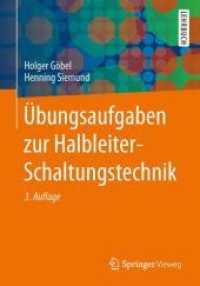- ホーム
- > 洋書
- > ドイツ書
- > Mathematics, Sciences & Technology
- > Biology
Full Description
This book constitutes the refereed proceedings of the 15th EAI International Conference on Bio-inspired Information and Communications Technologies, BICT 2024, held in Quzhou, China, during August 15-16, 2024.
The 16 full papers included in this book were carefully reviewed and selected from 52 submissions. They were organized in topical sections as follows: Asia-Pacific Workshop on Molecular Communications; Bio-inspired ICT; and ICT-inspired Biomedicine.
Contents
.- Asia-Pacific Workshop on Molecular Communications.
.- Industrial Perspectives for Molecular Communication in Future Networks.
.- Optimizing Drug Delivery Strategies by Pathway Analysis for Waveform Modulation-based Molecular Communication.
.- Enhancing DNA-based IoBNT Throughput and Reducing Congestion with Yin-Yang Coding.
.- A Molecular Communication Model Driven by Magnetic Field Force.
.- CDM Based on Izhikevich Neuron Model.
.- Multi-user Diffusive Molecular Communication Systems with A Passive Relay node: Receiver Design and Performance Analysis.
.- Machine Learning-Based Detection Time Estimation for Molecular Communication.
.- Taming Signal-dependent Counting Noise with Machine Learning for Molecular Communication.
.- Energy-Efficient Transmitter Creation in Molecular Communication.
.- A Method for Determining Relay Node location in Molecular Communication.
.- Glycemic Oscillation Decomposition-based Personalized Blood Glucose Prediction with Continuous Glucose Monitoring.
.- Bio-inspired ICT.
.- Bio-inspired Microstrip Antenna (Bi-MPA) for Medical Microwave Imaging Applications.
.- Image Encryption and Decryption Algorithm based on DNA Sequence: Performance Analysis of Channel Fusion Processing.
.- ICT-inspired Biomedicine.
.- Optimizing the Classification of SSVEP Signals in Brain-computer Interfaces: A Novel Sliding Window Data Segmentation Method Based on Weighted Voting Mechanism.
.- Spontaneous Motion of Nanorobots Inspired Computational Technology for Tumor Boundary Exploration.
.- Light-Driven Aggregation of Nanorobot Swarms for Precision Tumor Targeting in Manhattan-Geometry Vasculature.








